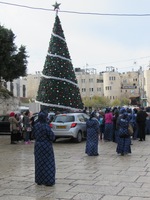My family and I made our first journey to the Holy Land in 2015 and spent Christmas in Bethlehem, where, for Christians, it all began. Many picture Bethlehem as it is romantically depicted on Christmas cards: sweet, clean, calm. What I found, however, behind the wall, beyond the checkpoints, is a vibrant, welcoming, tragic, and complicated place. I offered the following reflection at the Christmas Day service at Redeemer Lutheran Church in the Old City of Jerusalem.
If you didn't know a woman was giving birth, you might believe that she was dying. Even for the birthing woman, it can feel like death. In labor, my body ceases to be my own. Another life takes over. Its timing and rhythms and pace are in charge. There is no way back, no way around--only through. It is dangerous and overwhelming and unpredictable.
And yet... at the end of the process that feels like death, there is life--a very particular life. A squirming, slippery bundle of flesh and DNA that, no matter what, will challenge and surprise those who choose to nurture it.
On Christmas, we remember and celebrate that God not only initiated the birth of new life in the world--Jesus' life and new life for us all--but that God surrendered Godself to the process of birth, that risky, intense journey into incarnate life.
Last night, Christmas Eve, Mary went through her own labor, her own being borne, carried through a process that felt like death, a process she could not know until she'd experienced it. This morning she rests, and the Divine baby as well. More unknown things lie ahead, more deaths, more births, until finally in that spot a stone's-throw away from here (the Church of the Holy Sepulcher) her son entered his own final labor, borne along by human sin, facing his own unknown, and bringing to light life for us all.
Jesus' birth at Christmas is a hint of the Gospel promise: what looks like death can bring life.
St. Paul, in his letter to the Romans, reminds us that "the whole creation has been groaning in labor pains until now," and all around and within us we experience things that may look like death, that may look like the end, that are overwhelming and painful, and we maybe tempted to despair. But just as a birthing mother should not labor alone, we do not struggle alone. We tell the Christmas story every year, not just because babies are, mostly, wonderful, but because we need company in the process. We need to be reminded that Mary survived the birth, to sit side by side with others who struggle with us to bring God's love to light, to be know that, for 2,000 years, others--what we call the Communion of Saints--have labored and been faithful.
Christmas Eve is, of course, followed by Christmas morning. Mary's birthing labor has ended, but God's work of the world's redemption has just begun.
